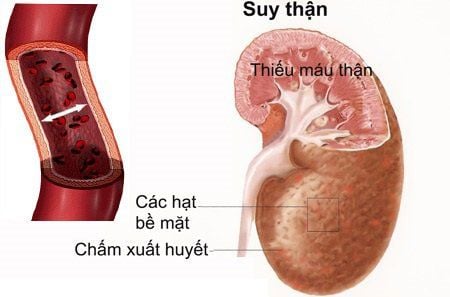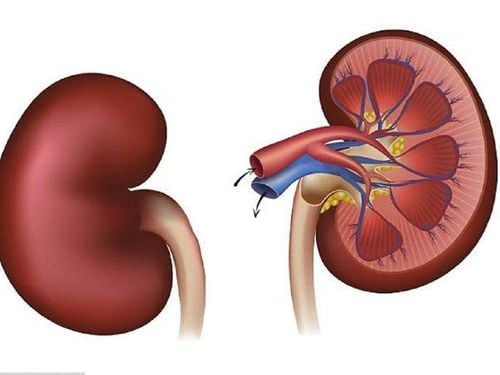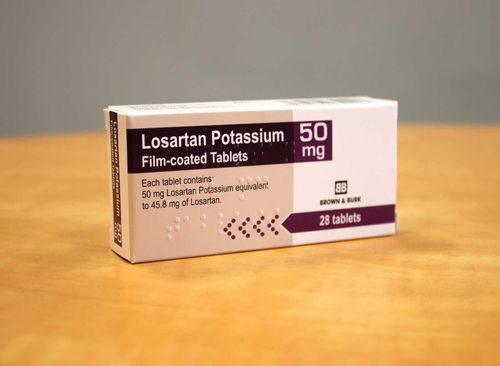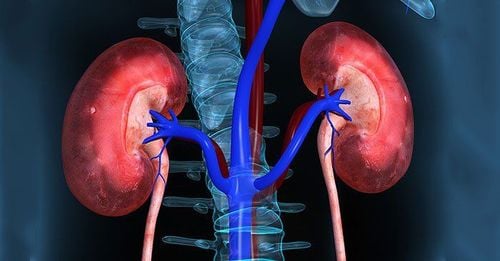This is an automatically translated article.
The article was professionally consulted with Specialist Doctor II Nguyen Quoc Viet - Department of Medical Examination & Internal Medicine - Vinmec Da Nang International General Hospital.Renal artery bypass grafting is indicated to control symptoms of renal artery stenosis and prevent complications. The patients most often indicated for renal vascular intervention are those with severe renal artery stenosis — greater than 60 to 70% of the artery's diameter. Meanwhile, people with no symptoms or evidence of impaired kidney function usually don't need surgery.
1. Percutaneous angioplasty and stenting
Renal artery bypass grafting with stenting is often the first procedure used for people with renal artery stenosis because it is minimally invasive and requires less recovery time than conventional surgery. often.Stenting and percutaneous balloon angioplasty can increase blood flow to the kidneys, lower blood pressure, and prevent complications such as permanent kidney damage.
During percutaneous balloon angioplasty, the endovascular surgeon makes a small incision in the thigh, guiding a flexible tube called a catheter through the femoral artery and into the narrowed renal artery. The doctor then inflates a surgical balloon located at the end of the catheter, pushing the plaque against the inner wall of the artery for better blood flow. This procedure is usually done immediately after renal angiography, which is used to diagnose renal artery stenosis.
Next, the doctor will place a stent — a metal mesh tube — in the blood vessel to act as a “scaffold”. Stents keep arteries open, increasing blood flow to the kidneys. Endovascular stents on renal arteries will remain in the same permanent position as coronary stents.
During surgery, a series of X-rays, called fluoroscopy, are used to help the doctor see the catheter and stent inside the artery. The procedure usually takes 30 to 90 minutes, depending on the severity of the renal artery stenosis.
Because renal vascular intervention by angioplasty and stenting is performed using local anesthesia and sedation, the patient has the ability to recover very quickly. Your doctor will determine the length of your stay in the hospital based on your medical history and overall health, while some people can go home on the day of the procedure.
After returning home, the sick person can resume his or her usual activities after two days. Most patients will be prescribed an antiplatelet drug, such as aspirin or clopidogrel, to prevent blood platelets from sticking to the stent, causing a blood clot, which causes restenosis in the stent.

2. Renal artery bypass surgery
In renal artery bypass surgery, blood flow is redirected, from around the blockage in one or more renal arteries, to the new "vascular" segment. The graft is made from a synthetic tube or a healthy vein from another part of the body.As with other major intra-abdominal surgeries, the patient needs to tell the doctor about all the medications he is taking, including over-the-counter medicines and if he is allergic to any medications. You will be asked not to eat or drink after midnight the morning of your surgery.
Renal artery bypass grafting is a major surgery performed through an incision in the abdomen under general anesthesia. During renal artery bypass grafting, a segment of a vessel created from a healthy vein is taken from the groin or arm or leg to attach to the blocked renal artery. In some cases where the autologous circuit cannot be found as required, the doctor will choose a graft made from synthetic materials.
Next, the doctor uses sutures to attach one end of the graft to the renal artery, between the blockage and the kidney. The other end is attached to the aorta, the largest artery in the body, the visceral artery, or the healthy artery in the abdomen. Bypassing these blocked renal arteries allows blood to flow freely to the kidneys. In other words, the new vessel would be grafted above and below the blockage in the renal artery, creating a new alternative route for blood to flow to the kidney.
At the end of the surgery, the patient will be closely monitored during the recovery period. Patients may stay in the hospital for 3 to 5 days after surgery, return to normal activities after about a month, and return for a follow-up visit a week or two later to remove skin sutures. Recovery can take two to four weeks.
After returning home, the patient should continue to take medication as directed by the doctor and monitor the graft's performance during regular follow-up visits.

3. Renal endothelium removal
Compared with the above two forms of renal artery intervention, endarterectomy is no longer commonly performed. The principle of this renal vascular intervention is that the doctor will remove the plaque that blocks the renal artery and restricts blood flow to the kidney and this process is done under general anesthesia.To perform endarterectomy, the doctor makes an incision in the abdomen or on the side of the ribs, opens the renal artery and aorta, and removes the plaque. Next, the doctor sutures the artery and closes the incision in the skin.
Renal endarterectomy usually requires a 5 to 7 day hospital stay, after which it can take three to four weeks to recover at home.
However, renal artery intervention in the form mentioned above only applies to cases of renal artery stenosis due to atherosclerosis, not other causes. At the same time, measures to limit the establishment of atherosclerosis such as controlling blood lipid levels, blood sugar, quitting smoking, should also be followed to prevent recurrent renal artery stenosis.
In summary, besides conservative treatment, renal artery interventions, including balloon angioplasty and stenting, bypass surgery, and endarterectomy, will help revascularize, improve renal function and prevent prevent complications. However, in order for the effectiveness of renal vascular interventions to be stable in the long-term, patients still need periodic renal artery monitoring as well as optimal medical treatment, limiting the possibility of re-stenosis in the future.
Above are some methods of renal artery intervention. Please follow the website: Vinmec.com regularly to update many other useful information.
Please dial HOTLINE for more information or register for an appointment HERE. Download MyVinmec app to make appointments faster and to manage your bookings easily.
Reference articles: vnha.org.vn, nyulangone.org, osu.edu













